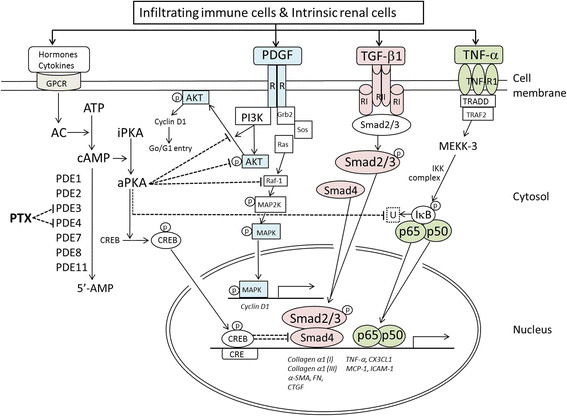Therapeutic efficacy of pentoxifylline on proteinuria and renal progression: an update
- PMID: 29132351
- PMCID: PMC5683556
- DOI: 10.1186/s12929-017-0390-4
Therapeutic efficacy of pentoxifylline on proteinuria and renal progression: an update
Abstract
Blood pressure control with renin-angiotensin system (RAS) blockade has remained the gold standard for treating patients with proteinuric chronic kidney disease (CKD) up to date. Nevertheless, RAS blockade slows but does not halt the progression of kidney disease, thus highlighting the need to search for additional therapeutic approaches. The nonselective phosphodiesterase (PDE) inhibitor pentoxifylline (PTX) is an old drug that exhibits prominent anti-inflammatory, anti-proliferative and anti-fibrotic activities both in vitro and in vivo. Studies in human subjects have shown that PTX monotherapy decreases urinary protein excretion, and add-on therapy of PTX to background RAS blockade additively reduces proteinuria in patients with CKD of various etiology. More recent studies find that PTX combined with RAS blockade delays the decline of glomerular filtration rate in diabetic patients with mild to moderate CKD, and reduces the risk of end-stage renal disease in diabetic and non-diabetic patients in late stage of CKD with high proteinuria levels. In this review, we update the clinical trial results of PTX as monotherapy, or in conjunction or in comparison with RAS blockade on patients with proteinuria and CKD, and propose a mechanistic scheme explaining the renoprotective activities of this drug.
Keywords: CKD; ESRD; Pentoxifylline; Proteinuria; Renin-angiotensin system.
Conflict of interest statement
Ethics approval and consent to participate
Not applicable.
Consent for publication
None.
Competing interests
The authors declare that they have no competing interests.
Publisher’s Note
Springer Nature remains neutral with regard to jurisdictional claims in published maps and institutional affiliations.
Figures

Similar articles
-
A review of the potential benefits of pentoxifylline in diabetic and non-diabetic proteinuria.J Pharm Pharm Sci. 2011;14(1):128-37. doi: 10.18433/j3bp4g. J Pharm Pharm Sci. 2011. PMID: 21501559 Review.
-
Pentoxifylline plus ACEIs/ARBs for proteinuria and kidney function in chronic kidney disease: a meta-analysis.J Int Med Res. 2017 Apr;45(2):383-398. doi: 10.1177/0300060516663094. Epub 2017 Jan 1. J Int Med Res. 2017. PMID: 28415944 Free PMC article.
-
Educational paper: Progression in chronic kidney disease and prevention strategies.Eur J Pediatr. 2012 Nov;171(11):1579-88. doi: 10.1007/s00431-012-1814-5. Epub 2012 Sep 12. Eur J Pediatr. 2012. PMID: 22968936 Review.
-
The effect of pentoxifylline on reduction of proteinuria among patients with type 2 diabetes under blockade of angiotensin system: a double blind and randomized clinical trial.Nefrologia. 2012;32(6):790-6. doi: 10.3265/Nefrologia.pre2012.Jun.11242. Nefrologia. 2012. PMID: 23169362 Clinical Trial.
-
Pentoxifylline ameliorates proteinuria through suppression of renal monocyte chemoattractant protein-1 in patients with proteinuric primary glomerular diseases.Kidney Int. 2006 Apr;69(8):1410-5. doi: 10.1038/sj.ki.5000302. Kidney Int. 2006. PMID: 16541021
Cited by
-
Cyclic Adenosine Monophosphate Signaling in Chronic Kidney Disease: Molecular Targets and Therapeutic Potentials.Int J Mol Sci. 2024 Aug 30;25(17):9441. doi: 10.3390/ijms25179441. Int J Mol Sci. 2024. PMID: 39273390 Free PMC article. Review.
-
Are Antioxidants Useful in Preventing the Progression of Chronic Kidney Disease?Antioxidants (Basel). 2021 Oct 23;10(11):1669. doi: 10.3390/antiox10111669. Antioxidants (Basel). 2021. PMID: 34829540 Free PMC article. Review.
-
Metabolic dysfunction-associated fatty liver disease increases risk of chronic kidney disease: a systematic review and meta-analysis.eGastroenterology. 2023 Aug 7;1(1):e100005. doi: 10.1136/egastro-2023-100005. eCollection 2023 Jun. eGastroenterology. 2023. PMID: 39944252 Free PMC article.
-
Aging and Renal Disease: Old Questions for New Challenges.Aging Dis. 2021 Apr 1;12(2):515-528. doi: 10.14336/AD.2020.0703. eCollection 2021 Apr. Aging Dis. 2021. PMID: 33815880 Free PMC article. Review.
-
A Potential Role of Ethosuximide and Pentoxifylline in Relieving Abdominal Pain in Irritable Bowel Syndrome Patients Treated with Mebeverine: A Randomized, Double-Blind, Placebo-Controlled Trial.J Inflamm Res. 2022 Feb 19;15:1159-1172. doi: 10.2147/JIR.S346608. eCollection 2022. J Inflamm Res. 2022. Retraction in: J Inflamm Res. 2022 Apr 14;15:2381-2382. doi: 10.2147/JIR.S369945. PMID: 35221706 Free PMC article. Retracted.
References
-
- Kidney Disease Improving global outcomes (KDIGO) blood pressure work group. KDIGO clinical practice guideline for the management of blood pressure in chronic kidney disease. Kidney inter, Suppl. 2012;2:337–414. doi: 10.1038/kisup.2012.46. - DOI
-
- Kidney Disease Improving global outcomes (KDIGO) CKD work group. KDIGO 2012 clinical practice guideline for the evaluation and management of chronic kidney disease. Kidney inter., Suppl. 2013;3:1–150. doi: 10.1038/kisup.2012.73. - DOI
-
- Taiwan chronic kidney clinical guidelines 2015. http://www.tsn.org.tw/UI/H/H00202.aspx [Article in Chinese].
Publication types
MeSH terms
Substances
Grants and funding
LinkOut - more resources
Full Text Sources
Other Literature Sources
Medical

